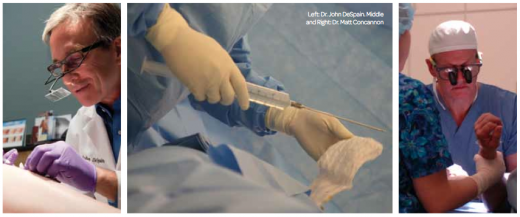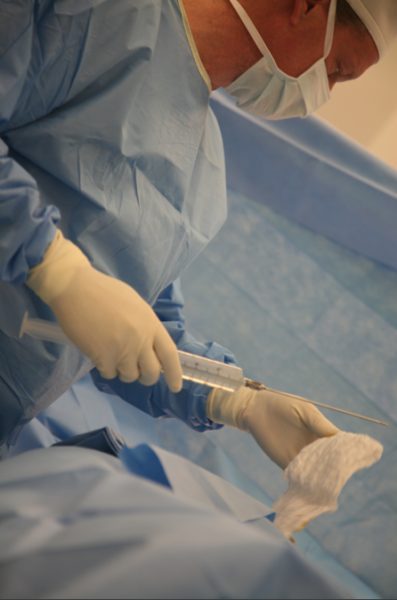Number of med spas up, tension levels down

Although most people are familiar with spas, chances are when it comes to medical spas, there is a bit of a learning curve. Wikipedia defines a medical spa as a facility “whose primary purpose is to provide comprehensive medical and wellness care in an environment that integrates spa services.” Basically, medical spas are an alternative to the typical hospital or clinic setting, and their popularity is gaining in leaps and bounds. In fact, the Boston Globe reports, “The number of medical spas — hybrids of medical clinics and day spas — has grown by 80 percent in the past two years and is now up to an estimated 4,250 nationally according to the International Medical Spa Association” (January 2012).
But what makes these alternative medical facilities so attractive to doctors and patients? And are they for everyone, or are there any risks involved in choosing these facilities over more traditional medical care?
A booming business
One reason medical spas are surging in popularity is due to their unique ambience. Although hospitals and clinics have come a long way from the institutional plastic chairs, outdated magazines and Spartan furnishings, they still barely hold a candle to the environment offered by most medical spas. With soothing music, soft comfy chairs, carefully chosen artwork and warm color schemes, medical spas provide the patient with a tranquil, calm setting and an escape from the daily grind not found in a typical hospital visit. But medical spas provide additional benefits as well, which are enticing many local doctors to open spas in the Columbia area.
For plastic surgeon, Dr. Matt Concannon, opening a medical spa was not something originally on his agenda but a process that evolved over time. A Harvard graduate, Concannon went into private practice in 2007 originally to provide hand injury patients an alternative to the typical hospital treatment, costs and protocol. But he was also looking forward to having his entire practice under one roof. “When I first set this business up, having our own OR was part of the business plan,” he says, recalling how at one time he did surgeries at three different places in one day.

Three and a half years ago, Concannon also began utilizing his operating room for breast lifts and used local anesthesia and light sedation. The response was so positive, it wasn’t long before he increased his services to offer a variety of breast surgery procedures, as well as body contours — from tummy tucks to liposuction — and spider vein removal. In April of this year, he officially opened his medical spa, which offers a wide variety of skin and body treatments, including: facials and chemical peels; manicures and pedicures; massages; body treatments such as waxing and airbrushed tans; laser hair removal; and photorejuvenation, a procedure that treats skin damage without disruption of the skin’s epidermal surface.
Similarly, dermatologist Dr. John DeSpain’s medical spa developed over time, but in his case it was primarily driven by patient demand. In private practice since 1992, DeSpain, who received his medical degrees from the University of Missouri and started writing prescriptions for Retin-A, a compound used to treat acne, back in the late 1980s. Over time, as patients became more informed about skin care, he added other cosmetic treatments and procedures to accommodate their needs, and his cosmetic business grew.
“My entry into cosmetic dermatology parallels perfectly the explosive growth of technology, patient demand and knowledge,” says DeSpain, who directs the DeSpain Cayce Dermatology Center and Medical Spa alongside dermatologist Dr. Kimberly Cayce. Their spa provides everything from facials to a wide variety of skin procedures that sculpt and tighten skin, eliminate wrinkles and restore lost volume. In addition, they treat sun-damaged skin and brown spots, remove tattoos and offer sclerotheraphy and laser treatments for veins.
All under one room
For patients, medical spas offer convenience, especially when it comes to providing comprehensive service in one location. For instance, DeSpain says, “Every patient we see, if interested in a cosmetic procedure, gets a customized treatment plan so we can come up with the best plan for them.”
Concannon agrees that this one-stop experience is attractive to his patients as well. “For us, the spa is integral with the medical practice. We now have the full spectrum to offer patients, ranging from microdermabrasion all the way to surgery.”
 In addition, because medical spas are typically smaller than most hospitals and clinics, patients receive a more personal touch. Kathy Concannon, Dr. Concannon’s wife and director of operations at the spa, says the more intimate nature of the spa allows the staff to not only greet each patient by name but also provide services in a timelier manner, respecting and valuing the patient’s time.
In addition, because medical spas are typically smaller than most hospitals and clinics, patients receive a more personal touch. Kathy Concannon, Dr. Concannon’s wife and director of operations at the spa, says the more intimate nature of the spa allows the staff to not only greet each patient by name but also provide services in a timelier manner, respecting and valuing the patient’s time.
Dr. Concannon finds working within the smaller medical spa allows him more time for his patients. “Every patient has my cellphone number,” he says. “If they have a problem, they can call me day or night or on the weekends. I don’t want them going to an ER where no one else knows them.”
For DeSpain the medical spa environment is also conducive to addressing and covering additional medical issues when they arise. “We are fellowship-trained in skin disease and know what melanoma, rosacea and what allergic reactions look like,” he says. “If a patient develops a complication, we are equipped to handle it.”
Additionally, medical spas can be more cost effective for both doctors and patients. According to Concannon, operating in his own OR eliminates extra hospital charges and anesthesiologist costs, which results in savings he can pass along to his patients. “Every procedure we do here is under local anesthesia or local with sedation,” he says, adding that as a result, his patients also recover more quickly. “Before they would wake up and feel awful, uncomfortable and sick. It’s hard to hold these ladies back now.”
For DeSpain, the medical spa environment provides a convenient way for his patients to purchase carefully selected skin care products and makeup, often at an attractive price. For instance, DeSpain offers Latisse, which helps grow lashes, at a better price than the box stores.
Danger in the loophole
Overall, medical spas provide patients another option in an expanding world of medical treatment centers. However, their surging popularity can also be problematic. Although several states are in the process of developing or have developed regulations on who can do aesthetic treatments, for now Missouri is not one of them. According to Jeff Howell, director of governmental relations and general counsel with the Missouri State Medical Association, regarding medical spas, there’s little oversight in Missouri at this time. “If the Board of Healing Arts, which promotes ethical standards, examination, licensure, regulation, investigation of complaints and discipline of individuals practicing in the field, gets a complaint that there’s someone that’s not licensed, and the board thinks they are practicing medicine, then the board can do something about it,” he says. “But they have to get a complaint. Usually this doesn’t happen until someone’s injured.”
In fact, according to the American Academy of Dermatology Association, “Currently, only a few states address the performance of medical aesthetic services or medical spa facilities.”
The AADA goes on to say that most existing state laws do not explicitly recognize medical aesthetic services as the practice of medicine and surgery. “These providers often have limited or no formal training or education in aesthetic medicine and may be operating with limited or no supervision by a licensed and qualified physician. As such, patient safety and quality of care can be jeopardized.” As a result, the AADA proposes all medical spa facilities should be licensed and also inspected on a regular basis to ensure compliance with all applicable federal and state laws.
For Concannon and DeSpain, this medical spa loophole is not only troublesome and frustrating, but it’s also a hard pill to swallow for patients considering medical spa care. “There’s a huge uprising of people who are trying to do plastic surgery that aren’t properly trained or board certified in plastic surgery,” says Concannon, whose own facility is accredited by the American Association for Accreditation of Ambulatory Surgery Facilities.
DeSpain agrees. “Medical spa services should be done in a medical setting, ideally by an expert in skin care, either a dermatologist or a plastic surgeon,” he says. “Not everybody is a good candidate for these procedures, and there are safety issues to consider.”


